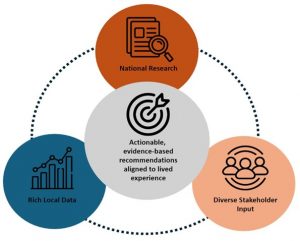What is Adequate School Funding for Washington, D.C.?
Understanding opportunities to build a stronger, more equitable system that enables students to thrive
The Context: Opportunity gaps persist despite strong funding.
The District of Columbia’s Uniform Per Student Funding Formula (UPSFF) guides the school funding for 251 school districts served by 70 Local Education Agencies across the region and acts as a key lever in promoting equitable resource allocation for nearly 100,000 students. DC is well funded through the UPSFF, with a 2023-24 base per student amount of just over $13,000.
Despite steady improvements across many measures over the last fifteen years, the District’s students still experience stubborn opportunity gaps in ways that don’t fall neatly into a “more money” = “better outcomes” explanation. The impacts of COVID-19 combined with the effects of intergenerational poverty warranted further investigation into how much funding schools have, how much they need, and how it’s being—and should be—spent.
The Goal: Develop a funding policy that aligns investment with intended outcomes and sets the stage for policy changes that provide students with the resources they need to thrive.
In 2023, the DC Office of the Deputy Mayor of Education (DME) set out to conduct a study to re-examine funding adequacy. They wanted to know:
- How do D.C. schools use their dollars today? What’s working and where are there gaps?
- How should the District allocate UPSFF dollars moving forward to accelerate learning and better support the unique needs of schools and students?
- How should the District allocate non-UPSFF dollars to build and maintain strong instruction and an ecosystem of student supports?
The Approach: A holistic design that centers the input of those most impacted
In pursuing the goal, we partnered with the D.C. DME to embrace four core tenets. These cornerstones helped us reconsider long-held assumptions and take the work at hand much deeper than a traditional adequacy study:
- Lean into the opportunity to dramatically rethink the role of the school, collective community resourcing, and use of resources at the system and school level;
- Design a student-focused funding policy solution that differentiates amongst schools/LEAs based on the unique context of the students they serve;
- Connect funding policy with other levers to encourage best practice and drive quality for effective use of funds; and
- Recognize that funding policy alone cannot address contributing factors of the opportunity gap but will work to ensure the best use of local dollars to support the full lives of our students.
Adequacy studies methods typically consist of national research review and application. For a richer understanding of the student, family, and school experience, we crafted an innovative research approach that triangulated national research, data about student needs, and deep and diverse stakeholder input. Our work combined a synthesized analysis of over 200 variables, 20 interviews with school leaders, and nearly 1,000 surveys of students, families, and educators.
It was through these multiple methods that the 2023 study examined:

- Student Needs: Identifying new or refined ways of thinking about/codifying student needs.
- Resource Needs: Utilizing various data, research, and input to understand what resources are needed for which students.
- Investment Levels: Identifying the level of local investments needed to achieve the goal of proficiency for all students.
- Funding Policy: Creating a funding policy proposal that addresses both adequacy and equity and is grounded in research, evidence, and lived experience.
- Contextual Recommendations: Identifying levers that can be used to support LEAs and schools and ensure effective use of funds toward student needs.
Our Insights
A community-informed way forward
We were able to synthesize the learnings from each methodology to create a list of informed options and considerations for addressing the resource challenges and outcome gaps that D.C. schools face. The use of multiple methodologies and the robust analysis of the insights they provided allowed us to craft a list of five actionable strategies. Each overarching strategy is composed of multiple levers of change that are informed by the community, as well as existing and new evidence gathered through our triangulation approach. They include:
- Adjusting the existing funding formula by changing weights to better support the unique needs of students.
- Providing grants and other funding outside of the formula for specific, proven interventions that focus on closing the opportunity gap and provide targeted staffing support
- Supporting schools’ ability to focus more on the instructional core by offering out of school programming and piloting innovative, neighborhood-based initiatives that support schools undergoing transformation through supplemental funding.
- Pursuing efficiency through employing benefits of scale with college and career programming, adding additional data to ensure accuracy of at-risk funding weights, and “price tagging” the opening of new schools to properly account for how they may require adjustments in the funding formula.
- Continuing to monitor the system via enhanced reporting and transparency to maintain an accurate understanding of how the funding systems are working and how dollars are spent.
Check out the full study to see our recommendations and process in detail.
The in-depth local data analysis and the voices elevated through the stakeholder engagement process now play a critical role in shaping the direction that D.C. will take in supporting their schools, educators, and students. The choice to use rigorous, innovative, and context-sensitive methods ensures that students’ and families’ needs and experiences remain at the center of policy decisions going forward.
At Afton, we put people first. Doing so results in stronger research design, more nuanced insights, and better decision-making. We are proud to come alongside communities to co-create both problem-solving processes and actionable solutions in a way that respects and engages those who stand to be most impacted. Ready to get started on yours? Get in touch.